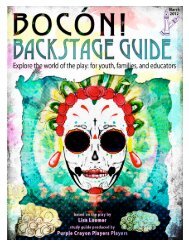Gardening, Migration, and Women's Agency: Stories from Rogers Park
Gardening, Migration, and Women's Agency: Stories from Rogers Park
Gardening, Migration, and Women's Agency: Stories from Rogers Park
Create successful ePaper yourself
Turn your PDF publications into a flip-book with our unique Google optimized e-Paper software.
<strong>Gardening</strong>, <strong>Migration</strong>, <strong>and</strong> Women’s <strong>Agency</strong>:<br />
<strong>Stories</strong> <strong>from</strong> <strong>Rogers</strong> <strong>Park</strong><br />
Alice Marquardt Cherry<br />
Home gardens are small, domestic enclosures in which people grow plants for<br />
food, medicine, <strong>and</strong> ornament. In the global South, women commonly keep home<br />
gardens, but many women migrants to the North discontinue the practice. In this<br />
study, I interview 25 South Asian immigrant women living in Chicago’s <strong>Rogers</strong><br />
<strong>Park</strong> who kept gardens before but not after migrating. I ask how they valued<br />
gardening <strong>and</strong> why they stopped. The results demonstrate that the interviewees<br />
found gardening satisfying, discontinued it reluctantly, <strong>and</strong> cope creatively with<br />
their loss. I argue that home gardens are valuable outlets for women’s agency.<br />
This study supports a research paradigm in which agency is dynamic <strong>and</strong> social.<br />
Introduction<br />
Home gardens are small systems of household plant production found in many<br />
societies, both rural <strong>and</strong> urban. i Women usually maintain home gardens, using edible<br />
produce for household subsistence (Niñez 5). In the global South, home gardening enjoys<br />
continuity through time <strong>and</strong> space (see, e.g., Greenberg); in many parts of the Indian<br />
subcontinent, for instance, home gardening is a widespread practice (Arunachalam 47;<br />
Wilson 211). ii Migrants to the North, however, frequently ab<strong>and</strong>on gardening: New York<br />
Latinos shop for medicinal plants in supermarkets <strong>and</strong> import herbs to stock their<br />
botánicas iii (Ososki et al 23), while many Bengali-American women in the Chicago area<br />
do not garden but rely upon grocery shopping (Ray 119). iv<br />
The South Asian immigrant women in this study gardened in their home countries<br />
but do not keep gardens in Chicago. v They gardened because they enjoyed it, not because<br />
they had to—because it fostered connections with family, friends, <strong>and</strong> neighbors, <strong>and</strong><br />
because it provided specific benefits in the form of fresh food, aesthetic beauty, <strong>and</strong><br />
respite, among other things. Thus, the women in this study exercised agency through
1<br />
gardening. After migrating, they stopped gardening not of their own accord but for<br />
reasons such as lack of space, with many taking creative measures to cope with their loss.<br />
Moreover, how the women in this study exercised agency through gardening—<strong>and</strong><br />
through their efforts to cope with its loss—has the potential to say something larger about<br />
agency. <strong>Agency</strong> cannot be fully represented by theoretical models that focus exclusively<br />
on individual autonomy, free will, <strong>and</strong> empowerment; forging social ties <strong>and</strong> responding<br />
creatively to constraints also constitutes agency.<br />
Methods<br />
I conducted the interviews at a South Asian community center in Chicago‟s<br />
<strong>Rogers</strong> <strong>Park</strong> neighborhood between December 2009 <strong>and</strong> February 2010. My contact, a<br />
program coordinator, recruited 25 first-generation immigrant women on my behalf, each<br />
of whom kept a home garden before migrating but does not keep one, or has not always<br />
kept one, in Chicago. The research method consisted of recorded interviews, ranging in<br />
length <strong>from</strong> 15 to 35 minutes, some with the help of an interpreter. vi I asked the<br />
interviewees why they gardened before migrating, why they had since stopped, <strong>and</strong> what<br />
they do (if anything) to replace gardening.<br />
The women in my sample are largely middle- or working-class vii , <strong>from</strong> India, <strong>and</strong><br />
Hindu. They range in age <strong>from</strong> 26 to 80. In their home countries, they were wealthier;<br />
like many South Asian immigrants, they experienced a decline in economic status after<br />
migration (see Kurien 161). This decline is reflected in a complete reversal in<br />
employment status among the women in my sample following migration, with just seven<br />
holding jobs before migration <strong>and</strong> 19 after. Nearly all came <strong>from</strong> cities—many <strong>from</strong><br />
Ahmedabad, Delhi, Mumbai, or Karachi. All migrated here within the last 20 years.
2<br />
Basic Characteristics of the Sample<br />
Category Sub-Category Number of Subjects<br />
Home Country India 22<br />
Pakistan 2<br />
Bangladesh 1<br />
Social Status in Home<br />
Country viii Middle- or Upper-Class 22<br />
Poor 3<br />
City or Suburb 21<br />
Village 4<br />
Geographic Location in Home<br />
Country<br />
Religion Hindu 21<br />
Muslim 4<br />
Age 60 or older 8<br />
40-59 13<br />
Younger than 40 4<br />
Job in Home Country ix Yes 7<br />
No 18<br />
Job in Chicago Yes 19<br />
No 6<br />
Garden in Home Country Yes 25<br />
No 0<br />
Garden in Chicago Yes 3<br />
No 22<br />
Background<br />
Home gardens in South Asia, especially in urban areas, are compact as a result of<br />
population density (Niñez 23). Compared to rural gardens, urban gardens are less<br />
important economically; they are also more likely to be used for play <strong>and</strong> relaxation<br />
(Niñez 22; Bhatti <strong>and</strong> Church 200, 188). Not surprisingly, then, my interviewees said that<br />
their gardens were small, located directly adjacent to the house or apartment, <strong>and</strong> (in most<br />
cases) not economically essential. x Despite this last fact, however, the women in this<br />
study grew a wide range of plants, both edible <strong>and</strong> decorative; xi they also describe the<br />
utilitarian benefits of their gardens during the interviews.<br />
<strong>Gardening</strong> practices of South Asian migrant women lie at the nexus of<br />
overlapping fields of study on agency, feminism, <strong>and</strong> diaspora. <strong>Agency</strong> is “the human<br />
capacity for reflective action” (Frie 1); in Western philosophy it is defined primarily in<br />
terms of free will, empowerment, <strong>and</strong> the autonomy of the individual (Grimshaw 146-
3<br />
161; Raisborough <strong>and</strong> Bhatti 463). Some feminist literature has conceptualized women‟s<br />
agency in particular as a form of resistance to normative gender relations, <strong>and</strong> the degree<br />
to which unpaid household work supports immigrant women‟s agency is a subject of<br />
disagreement (see Pessar, Vidbha). Wilson (224) speculates that women in rural<br />
Bangladesh would not garden if they had more economic opportunities; however, other<br />
studies have established links between gardening <strong>and</strong> women‟s agency—for instance, the<br />
efforts of Hmong women in Sacramento to provide fresh, culturally appropriate food for<br />
their families (Corlett et al); women‟s gardening as a means to earn discretionary income<br />
<strong>and</strong> exp<strong>and</strong> social networks in central Anatolia, Turkey (Ertug 194); <strong>and</strong> the economic<br />
<strong>and</strong> cultural stability provided by women‟s gardening in northeast Thail<strong>and</strong> (Moreno-<br />
Black et al) <strong>and</strong> among Yucatec Mayan immigrants in Cancún, Mexico (Greenberg).<br />
Results<br />
Gardens of <strong>Agency</strong>: “This [<strong>Gardening</strong>] is Myself”<br />
Not only did the women in this study assert that they gardened of their own<br />
volition rather than because of cultural expectation or economic need (or, in a few cases,<br />
in addition to the latter), but they identified specific reasons for gardening. The most<br />
consistent theme to emerge <strong>from</strong> the interviews is the ability of gardening to strengthen<br />
ties with family members, friends, <strong>and</strong> neighbors. Many of the women traded surplus<br />
produce with that of neighbors, explaining that each neighbor grew something different;<br />
in other cases, they gave away excess produce as gifts. As one woman <strong>from</strong> Karachi<br />
explains, gardens were not the only source of these gifts, nor would the exchange have<br />
been impossible without gardens; however, it made her especially proud to give gifts
4<br />
<strong>from</strong> her garden. These responses highlight an aspect of agency that has more to do with<br />
social interaction <strong>and</strong> social ties than with individual autonomy.<br />
Gardens also strengthened family ties. One interviewee remembers that her<br />
mother-in-law taught her to garden as part of her initiation into the family; another<br />
explains that her parents asked her to maintain the family garden after their death. A few<br />
interviewees recall playing in the family garden as children, eating fruit straight <strong>from</strong> the<br />
branch—or of gr<strong>and</strong>parents showing them, as children, how to save <strong>and</strong> plant seeds.<br />
These interviewees say they kept gardens in part to keep alive their parents‟ way of life,<br />
or to satisfy nostalgia for their childhood. Thus, gardening was an important part of their<br />
identity; as Krishna, a 47-year-old <strong>from</strong> Mumbai, puts it, “This [gardening] is myself”.<br />
Yet it was not an individualistic kind of identity to which they refer, but rather an identity<br />
rooted in family <strong>and</strong> tradition.<br />
Over half of the interviewees say they kept gardens because they love plants.<br />
Sangeeta, a 62-year-old <strong>from</strong> Delhi, says simply, “It‟s a loving thing”. Some of the<br />
women recount talking to their plants <strong>and</strong> playing music for them because they were<br />
convinced plants grow better this way; Krishna, for instance, says she <strong>and</strong> her brother<br />
used to drag the tape player onto the balcony so the roses could hear it. A few<br />
interviewees compare caring for plants to raising children, <strong>and</strong>, in some cases, plants<br />
seem to have actually replaced children who are now grown: Durga, a 64-year-old <strong>from</strong><br />
Delhi, explains of her formerly live-in gr<strong>and</strong>parents,<br />
“They are just taking care of…[these] plants like their children. You know, in the<br />
morning they will go <strong>and</strong> they will say, „Oh, this one yesterday, the<br />
leaves…[were] not there!‟…”
5<br />
In these instances, gardening was clearly not a household chore akin to doing dishes or<br />
laundry; again <strong>and</strong> again, my interviewees remind me that, although gardening brought<br />
them utilitarian benefits, they did not experience it as a burden.<br />
In fact, two woman describe gardening as a respite <strong>from</strong> household life: Zeenat, a<br />
45-year-old <strong>from</strong> Karachi, tells me that gardening distracted her <strong>from</strong> the truly arduous<br />
task of washing her family‟s clothes by h<strong>and</strong>. Another woman, also <strong>from</strong> Karachi, says<br />
she lived in a noisy household <strong>and</strong> most appreciated her garden for its “peace <strong>and</strong> quiet”.<br />
In these instances, gardening was a deliberate effort to overcome circumstances that the<br />
women found disempowering. However, as Raisborough <strong>and</strong> Bhatti argue in a similar<br />
context, it would be a mistake to focus on the “transformative power of individual<br />
agency” in these accounts; rather, agency is constituted by “daily creative negotiations in<br />
social contexts <strong>and</strong> conditions that lie outside of individual control” (466).<br />
Coping Mechanisms: “I am [still] happy...”<br />
Because of space constraints, time constraints, <strong>and</strong> the cost of hired help, very few<br />
of the interviewees keep gardens in Chicago; however, most of them engage in activities<br />
that help them cope with the loss of their gardens. A few of the luckier women<br />
describe—with clear excitement—their plans to move to the suburbs, where they will<br />
resume gardening. For those less fortunate, a popular strategy is to grow potted plants<br />
indoors, especially the herb tulsi (Holy Basil). Kirti, a 54-year-old kitchen worker at the<br />
community center, says her friends tease her for turning her apartment into a greenhouse.<br />
A second popular coping mechanism is to seek out homegrown food: Several<br />
interviewees make an extra effort to purchase food that is organically grown, <strong>from</strong>
6<br />
farmers‟ markets, or imported <strong>from</strong> their home countries so as to re-experience the purity,<br />
freshness, <strong>and</strong> flavor of the food they used to grow.<br />
Interestingly, many of coping mechanisms mentioned during the interviews<br />
recreate the strengthening of social <strong>and</strong> family ties discussed above. A few interviewees<br />
say that their friends or neighbors gave them permission to use their own gardens.<br />
Krishna, for example, grew cucumbers in her friend‟s garden. Although she lost them to<br />
hungry squirrels, she prizes the experience: “I said, „It‟s OK, squirrel‟…I am [still] happy<br />
at that time, you know” Two other interviewees have taken to collecting seeds <strong>and</strong><br />
giving them as gifts to admiring friends, relatives, <strong>and</strong> co-workers; another—one of the<br />
fortunate few with a garden in Chicago—freezes food <strong>from</strong> her garden <strong>and</strong> sends it to<br />
relatives elsewhere in the U.S. Finally, a few interviewees make an extra effort to keep in<br />
touch with friends <strong>and</strong> relatives back home who tend their old gardens. Asha asks her<br />
relatives for updates on the status of the garden, while Jyoti says it comforts her to know<br />
that her old garden still exists <strong>and</strong> that her brother takes good care of it.<br />
Conclusions<br />
In this study, immigrant women exercise agency by gardening in their home<br />
countries <strong>and</strong> by devising creative solutions to replace gardening after arriving in<br />
Chicago. In both cases, their agency takes a form that cannot be fully explained by<br />
Western neoliberal models of agency, which focus exclusively on free will, autonomy,<br />
<strong>and</strong> empowerment. Rather, agency is expressed through social ties <strong>and</strong> family traditions<br />
embedded in the practice of gardening. It is also expressed through creative responses to<br />
constraints, both in Chicago <strong>and</strong> the women‟s home countries; as Wray contends, “…it is<br />
possible to be…empowered <strong>and</strong> disempowered at the same time” (23). Building upon
7<br />
earlier studies, this study proposes a link between gardening <strong>and</strong> the exercise of agency.<br />
It also proposes a new theoretical framework for agency, one in which social connections<br />
<strong>and</strong> creative responses to constraints are considered. However we define agency <strong>and</strong> the<br />
activities that constitute it, it should be possible to ascribe agency to people in diverse<br />
circumstances. I hope that further studies on agency will leave room for roses <strong>and</strong> tape<br />
players, squirrels <strong>and</strong> cucumbers, <strong>and</strong> other stories <strong>from</strong> <strong>Rogers</strong> <strong>Park</strong>.<br />
Acknowledgements<br />
I owe many thanks to the faculty reviewers for their wonderful suggestions, not<br />
all of which could be incorporated because of space constraints. I also want to thank the<br />
following individuals for their generous feedback: Micaela di Leonardo, Professor of<br />
Anthropology <strong>and</strong> advisor to my senior thesis; John Millhauser, senior seminar TA;<br />
Helen Schwartzman, Department of Anthropology Director of Undergraduate Studies;<br />
Jana Measells, Undergraduate Research Advisor; <strong>and</strong> Peter Civetta, Undergraduate<br />
Research Grants Coordinator. An undergraduate research grant funded this study.<br />
Notes<br />
i Many names exist for this type of garden. I have chosen the term “home garden” to reflect<br />
the small-scale, domestic nature of the gardens in this study. I did not use “kitchen garden”<br />
because some of the interviewees grew ornamental plants.<br />
ii<br />
In this study, I use the terms “garden” <strong>and</strong> “gardening” as shorth<strong>and</strong> for “home garden” <strong>and</strong><br />
“home gardening”.<br />
iii<br />
Botánicas are “shops that sell traditional remedies <strong>and</strong> function as herbal pharmacies”<br />
(Ososki et al 2007, 17).<br />
iv “North” <strong>and</strong> “South” refer to the global North <strong>and</strong> South. This terminology reflects a rough<br />
geographic line of division in the distribution of home gardens worldwide (with most in the<br />
South) <strong>and</strong> is commonly used in the literature on home gardens. It also fits the epistemic<br />
frame of this study better than the “developed/developing” terminology.<br />
v<br />
With a few exceptions; see the Methods section.<br />
vi<br />
I arranged for a Hindi-speaking graduate student to interpret interviews with women who<br />
did not speak English. Because a small number of interviewees spoke neither English nor<br />
Hindi but Gujarati, my contact interpreted when necessary.<br />
vii<br />
According to my contact. Her information seems accurate, given the jobs the women hold,<br />
where they live in Chicago, <strong>and</strong> the composition of similar community centers nearby (see,<br />
e.g., Rudrappa’s description of the Indo-American Center, p. 100).
8<br />
viii<br />
Based on my contact’s information, the interviewees’ descriptions of how they used their<br />
gardens, where they lived before migrating, <strong>and</strong> my own rough knowledge of social class in<br />
India. All three interviewees classified here as “poor” came <strong>from</strong> villages.<br />
ix<br />
These data include part-time but not volunteer work. The same is true of the jobs data for<br />
Chicago.<br />
x<br />
Only a few of the interviewees—those who came <strong>from</strong> villages—described their gardens as<br />
economic necessities. Because of the sensitivity of this subject <strong>and</strong> the difficulty of eliciting<br />
direct answers, I asked both direct <strong>and</strong> indirect questions.<br />
xi<br />
The following list summarizes the plants most often mentioned during the interviews:<br />
tomato, potato, onion, garlic, okra, eggplant, chili pepper, basil, mint, lime, jasmine, mango,<br />
date, papaya, rose, sunflower, <strong>and</strong> various squashes, gourds, melons, <strong>and</strong> pulses.<br />
References<br />
Arunachalam A. 2009. Role of Traditional Home Garden Systems in Northeast India. Indian<br />
Journal of Traditional Knowledge 8.1: 47-50.<br />
Bhatti M, Church A. 2000. “I Never Promised You a Rose Garden”: Gender, Leisure, <strong>and</strong> Home-<br />
Making. Leisure Studies 19: 183-197.<br />
Corlett JL, Dean EA, Grivetti LE. 2003. Hmong Gardens: Botanical Diversity in an Urban Setting.<br />
Economic Botany 57.3: 365-379.<br />
Ertug F. 2003. Gendering the Tradition of Plant Gathering in Central Anatolia (Turkey). In<br />
Women <strong>and</strong> Plants: Gender Relations in Biodiversity Management <strong>and</strong> Conservation, ed<br />
Howard P. London: Zed Books.<br />
Frie R. 2008. Psychological <strong>Agency</strong>: Theory, Practice, <strong>and</strong> Culture, ed Frie R. Cambridge,<br />
Massachusetts: MIT Press.<br />
Greenberg LSZ. 2003. Women in the Garden <strong>and</strong> Kitchen: The Role of Cuisine in the<br />
Conservation of Traditional House Lot Crops among Yucatec Mayan Immigrants. In<br />
Women <strong>and</strong> Plants: Gender Relations in Biodiversity Management <strong>and</strong> Conservation, ed<br />
Howard P. London: Zed Books.<br />
Grimshaw J. 1986. Philosophy <strong>and</strong> Feminist Thinking. Minneapolis: University of Minnesota<br />
Press.<br />
Howard P. 2003. Women <strong>and</strong> the Plant World: An Exploration. In Women <strong>and</strong> Plants: Gender<br />
Relations in Biodiversity Management <strong>and</strong> Conservation, ed Howard P. London: Zed<br />
Books.<br />
Kurien P. 1999. Gendered Ethnicity: Creating a Hindu Indian Identity in the United States. In<br />
Gender <strong>and</strong> U.S. Immigration: Contemporary Trends, ed Hodagneu-Sotelo P. Berkeley:<br />
University of California Press.
9<br />
Moreno-Black G, Prapimporn S, Thamathawan S. 2005. Cultivating Continuity <strong>and</strong> Creating<br />
Change: Women’s Homegarden Practices in Northeastern Thail<strong>and</strong>. Agriculture <strong>and</strong><br />
Human Values 13.3: 3-11.<br />
Niñez VK. 1984. Household Gardens: Theoretical Considerations on an Old Survival Strategy.<br />
Potatoes in Food Systems Research Series, Report No. 1. Lima, Peru: International Potato<br />
Center (CIP).<br />
Ososki AL, Balick MJ, Daly DC. 2007. Medicinal Plants <strong>and</strong> Cultural Variation across Dominican<br />
Rural, Urban, <strong>and</strong> Transnational L<strong>and</strong>scapes. In Traveling Cultures <strong>and</strong> Plants: The<br />
Ethnobiology <strong>and</strong> Ethnophamacy of Human <strong>Migration</strong>s, ed Pieroni A, V<strong>and</strong>ebroek I. New<br />
York: Berghahn Books.<br />
Pessar PR. 1995. On the Homefront <strong>and</strong> in the Workplace: Integrating Immigrant Women into<br />
Feminist Discourse. Anthropological Quarterly 68.1: 37-47.<br />
Raisborough J, Bhatti M. 2007. Women’s Leisure <strong>and</strong> Auto/Biography: Empowerment <strong>and</strong><br />
Resistance in the Garden. Journal of Leisure Research 39.3: 459-476.<br />
Ray K. 2004. The Migrant’s Table: Meals <strong>and</strong> Memories in Bengali-American Households.<br />
Philadelphia: Temple University Press.<br />
Rudrappa S. 2004. Ethnic Routes to Becoming American: Indian Immigrants <strong>and</strong> the Cultures<br />
of Citizenship. New Brunswick, NJ: Rutgers University Press.<br />
Vibha B. 2008. Couch Potatoes <strong>and</strong> Super-Women: Gender, <strong>Migration</strong>, <strong>and</strong> the Emerging<br />
Discourse on Housework among Asian Indian Immigrants. Journal of American Ethnic<br />
History 27.4: 71-99.<br />
Wilson M. 2003. Exchange, Patriarchy, <strong>and</strong> Status: Women’s Homegardens in Bangladesh. In<br />
Women <strong>and</strong> Plants: Gender Relations in Biodiversity Management <strong>and</strong> Conservation, ed<br />
Howard P. London: Zed Books.<br />
Wray S. 2004. What Constitutes <strong>Agency</strong> <strong>and</strong> Empowerment for Women in Later Life The<br />
Sociological Review 52.1: 22-38.











